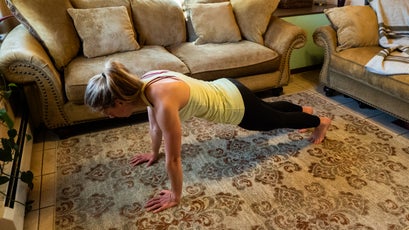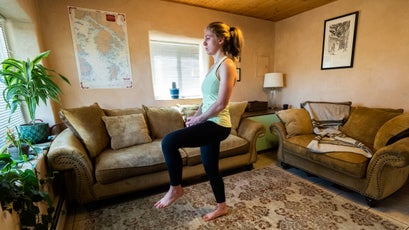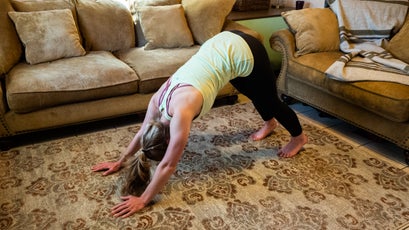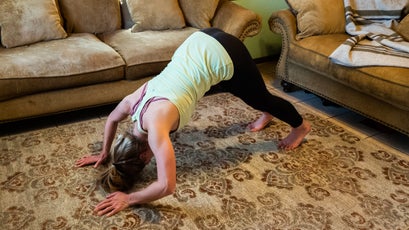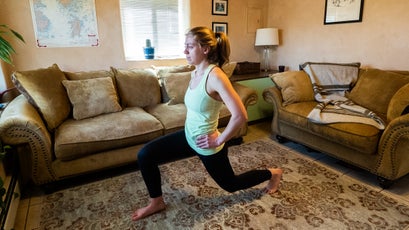When you donÔÇÖt have weights╠řat home, strength training can be a challenge. For stronger athletes, simple bodyweight exercises and endless repetitions are╠řprobably not╠řenough to stimulate a strength-training effect. ThatÔÇÖs because, once you do╠řmore than 15 to╠ř20 repetitions, you enter the zone of muscular endurance and conditioning╠řrather than strength training, says John Mark Seelig, captain of the and owner of ╠řin Edwards, Colorado. ÔÇťDoing a bunch of reps might work for somebody for a couple of weeks, maybe a month,ÔÇŁ he says, ÔÇťbut long-term, itÔÇÖs not very effective, and the repetitive motion can lead to overuse injuries.ÔÇŁ Without weights or gym equipment, how can you keep the rep scheme low while making the intensity high enough to build strength?
ÔÇťWith my athletes, IÔÇÖve introduced isometrics and tempos to their at-home programming,ÔÇŁ Seelig says. Isometric exercises force╠řmuscles to contract without changing length (think static holds, like wall sits, planks, and lock-offs). Tempo╠řincreases musclesÔÇÖ time under tension╠řand emphasizes the eccentric phase of muscle contraction (when muscle fibers elongate under a load, also called negatives). ÔÇťThese techniques are incredibly effective for strength,ÔÇŁ Seelig says. ÔÇťYou donÔÇÖt need additional weight, and you can continue to progress through╠řthe workout in a linear fashion by adjusting the timing.ÔÇŁ For those who want to improve upon╠řtheir training routines at home, he recommends these moves for a full-body strength workout.
Start with a good warm-up: run for five minutes, then cycle through three rounds of pull-ups, air squats, push-ups, and single-leg straight-leg deadlifts, performing ten╠řreps each at a steady pace. Gradually increase your╠řspeed and intensity each round. For the workout itself, aim for three to four sets of each exercise, with one to two minutes of rest between each effort. When youÔÇÖre counting reps, donÔÇÖt go until complete failure. ÔÇťThatÔÇÖs a common mistake I see with home-gym workouts,ÔÇŁ says Seelig. Adjust your╠řintensity so that you always have one to two reps left in the tank during╠řeach set.
ÔÇťEven if youÔÇÖre not training for a specific goal or race, know this will help you maintain your strength. More importantly, itÔÇÖs going to be good for your mental health,ÔÇŁ╠řSeelig says.
The Moves
Squat Hold
What it does: Strengthens the quads, glutes, hamstrings, calves, and core.
How to do it: Stand with your feet shoulder-width apart or slightly wider. Hold your chest and head high, pull your shoulders back and down, and keep your spine stacked in a neutral position. Then lower into a squat until your thighs are slightly below parallel to the floor (or as low as you can go with good form). Hold this position for 30 to 45 seconds. Then engage your glutes, and push through your heels to stand. ÔÇťIf you canÔÇÖt reach 30 seconds, reduce the range of motion to a manageable level by staying higher in the squat,ÔÇŁ says Seelig. ÔÇťIf you can easily get to 45 seconds, add weight.ÔÇŁ If you donÔÇÖt have free weights, fill a backpack with canned food, water bottles, rocks, textbooks, or anything thatÔÇÖs heavy until you can hit the target time range.
Push-Up Hold
What it does: Strengthens the chest, triceps, shoulders, back muscles, and core.
How to do it: Start in a standard push-up position, with your arms straight, your hands below your shoulders, and your feet together. Maintain a rigid plank form, with your body in a straight line from your heels to your head. Bend your elbows backwards along your sides to lower your chin and chest until they are an inch or two from the floor. Hold this position for 30 to 45 seconds, then push back up to the starting position.╠ř╠řÔÇťThis is very challenging,ÔÇŁ says Seelig. ÔÇťIf you canÔÇÖt get to 30 seconds, elevate╠řyour hands on a bench, cooler, or some raised╠řsurface. If you can easily hit 45 seconds, elevate your feet.ÔÇŁ
Too monotonous? Mix it up with the . Play , and lower every time you hear ÔÇťdown.ÔÇŁ Hold the low position until you hear ÔÇťup,ÔÇŁ and continue like this for the duration of the songÔÇöif you can make it until the end.
Tempo Single-Leg Deadlift
What it does: Emphasizes the eccentric (lowering) phase of the movement to strengthen the hamstrings and glutes,╠řwhile training balance.
How to do it: Stand on one leg, with a slight bend in your knee. Engage your core, and square your hips. Then, without rounding your back, reach forward and down toward the floor slowly (taking three to five seconds),╠řlifting your free leg behind you until your upper body and leg are in the same plane, parallel to the floor╠řor as far as you can go with good form.╠řPause for a second, then reverse the movement for one repetition. Keep your hips level (point your raised foot toward the floor) and your back straight throughout the movement. Focus on leg control and balance. To make it even harder, extend the duration of the lowering phase.
Volume: Eight╠řto twelve╠řreps on╠řeach leg. Complete all reps on one leg before switching to the other.
Tempo Pike Push-Up
What it does: Strengthens the shoulders, triceps, chest, upper back, and core.
How to do it: Start in a downward-facing dog position, with your feet together and your hands just wider than shoulder-width apart (the closer your feet are to your hands, the harder the exercise). Then slowly (taking three to five seconds) bend your elbows╠řand╠řlower╠řyour head between your hands, just above the floor. Hold the low position for a second or two, then push back up to the starting position for one repetition. Keep your hips high and╠řyour heels low, and maintain the inverted V position throughout the movement.
Volume: Eight╠řto twelve╠řreps.
Split-Squat╠řHold
What it does: Primarily strengthens the glutes, quads, and inner thighs,╠řwhile also working the hamstrings, calves, hip stabilizers, and core.
How to do it: Stand tall, with your feet hip-width apart, square your hips, and engage your core. Then take a large step backwards to enter a split-squat stance (also known as a stationary lunge). Bend your knees to lower your hips until your front thigh is roughly parallel to the ground and your back knee is hovering just an inch or two off the floor. Hold this low position for 30 to 45 seconds, then engage both legs to stand╠řfor one repetition. Keep your chest high, your pelvis neutral, your torso upright, and your back straight throughout the movement.
Volume: Eight╠řto twelve╠řreps on╠řeach leg. Complete all reps on one leg before switching to the other.
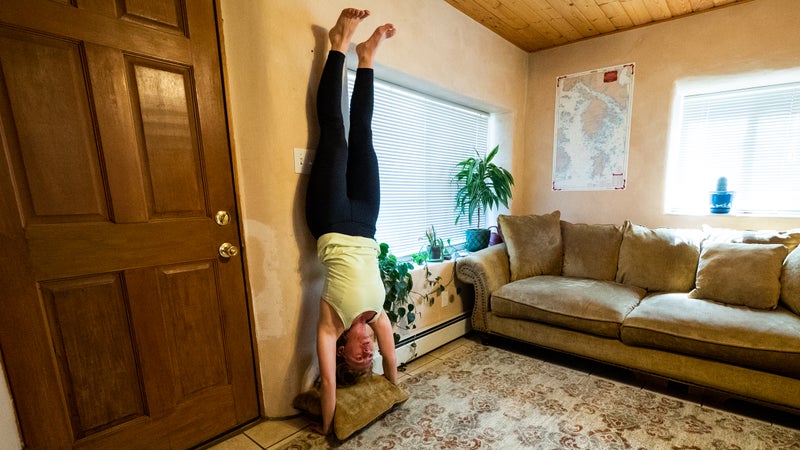
Handstand Hold
What it does: Builds upper-body and core strength╠řand trains balance, body awareness, deep breathing, and focus.
How to do it: Enter a handstand, either unassisted╠řor with your heels up against a wall. Hold this position for 30 to 45 seconds. Remember to breathe.




